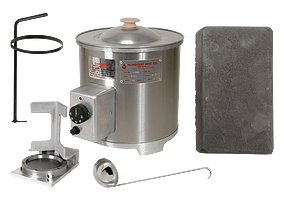
H-2951V.XX
Cylinder Capping Kit, Vertical
Kit provides the basic components for cylinder capping
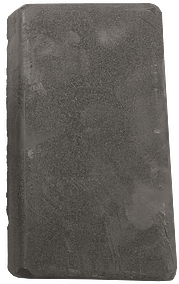
H-2959VH
VITROBOND® High Strength Capping Compound, 50# Ingot
Is a mineral-filled, sulfur-based ingot compound formulated for capping concrete test cylinders.
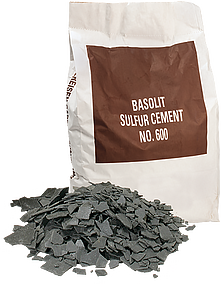
H-2959
Capping Compound, Flake-Style
50 lb bag of Sauereisen No. 600 sulfur-based, flake-form capping compound melts and sets within minutes
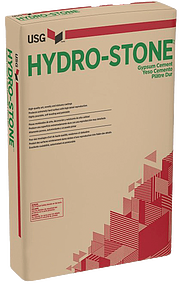
H-2959HS
Hydro-Stone Gypsum Cement, 50lb. bag
Exceptionally strong gypsum cement designed for stretch-press dies and producing cope-and-drag equipment.
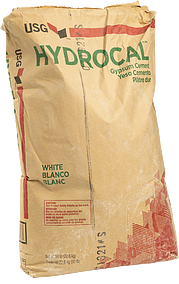
H-2959H
Hydrocal White Gypsum Cement, 50lb. bag
A good multi-purpose capping compound
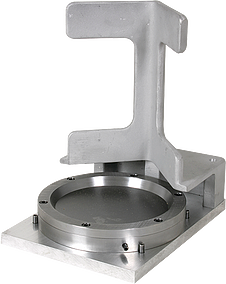
H-2952
Concrete Cylinder Capper, Vertical, 6" x 12" Cylinders
Simplifies capping process by assuring plane end surfaces are right angles to the axis of the cylinder
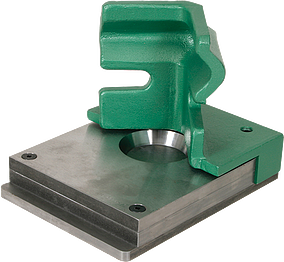
H-2925A.XX
Vertical Cylinder Capper
For capping various-sized concrete test cylinders when making compression tests

HCM-0119LS
Leather Compression Shim (4-Pack)
Used with concrete cylinders
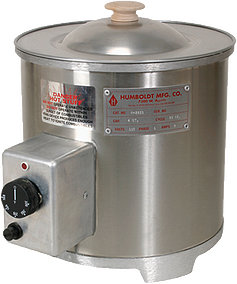
H-2953.XX
Compound Melting Pots
Designed for melting capping compound, paraffin and similar materials
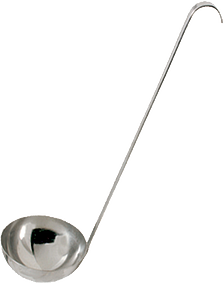
H-2958
Capping Ladle
Stainless steel ladle with 4" (102mm) dia. bowl
Capping
In order to ensure accurate results when performing compressive strength testing of concrete test cylinders, the ends of test cylinders must have a smooth, parallel and uniform bearing surface perpendicular to the applied axial load for accurate results. If the cylinder ends are not perfectly uniform and parallel to one another, the measured strength of the concrete becomes weaker due to built-up stress within the cylinder. Compliance specifications for the planeness and perpendicularity of test specimens is outlined in ASTM C39.
Typically, when making test cylinders for compression testing, the ends of the cylinders do not meet the compliance specifications for the planeness and perpendicularity as outlined in ASTM C39. One of the most popular methods of correcting this is the use of capping materials, such as sulfur-based or gypsum cement capping compounds, which are melted in a melting pot and applied to the ends of the test cylinders to form a plane surface perpendicular to the specimen axis to evenly distribute loading forces. Specifications for the planeness and perpendicularity of specimens This procedure is outlined in ASTM C617 and AASHTO T 231 specifications.
These capping compounds tend to be economical, especially when testing large numbers of cylinders, and, is often the preferred end treatment for cylinder ends because of their reliability and long-time use. Reliable strength results and consistent display of fracture patterns are predictable and well understood. In some cases, capping compounds are acceptable for testing high-strength concrete mixes.
Sulfur capping compounds tend to be the most widely used material for this application. It is typically comprised of a sulfur/mortar composition using additives like fly ash or plasticizers to modify strength, useability and curing speeds of the material. Sultur-based capping compounds are produced in flakes for fast, even melting, or solid ingots for convenient storage and handling.
Required Lab Equipment for Sulfur-based Compounds
Equipment needed for the preparation and application of Sulfur-based capping compounds tend to be cost-effective and uncomplicated to use. Most equipment required tends to be a one-time cost as it can be used for years.
Melting Pot—
A quality melting pot, like those provided by Humboldt, melts the capping compound evenly. Their replaceable heating elements, secured to the bottom and sides of the pot, provide even heat distribution for fast and even melting of the capping compound. Their even distribution of heat prevents dangerous pressurization of the partially melted compound. They feature an adjustable thermostat to deliver close temperature control automatically from 100° to 320°F (37.8 to 160°C). Maintaining the correct temperature avoids overheating, excessive fumes, and damage to the properties of the capping material. Melting pots are available in multiple sizes to accomodate any size operation. The ideal melting pot capacity should produce enough capping compound to cap all the cylinders to be tested for a given day.
Cylinder Capper—
A cylinder capper, H-2952 or H-2925A, produces a cap of the correct thickness correctly aligned with the concrete cylinder. The heavy steel fixtures are precision machined for planeness and perpendicularity and typically bolted to a benchtop. Heavy-duty vertical cylinder cappers are used for applying capping compound to concrete test cylinders in preparation for compression tests. The cylinder capper simplifies the capping process by ensuring that the test cylinder end surfaces are plane and at right angles to the axis of the cylinder. The upright is used as a guide for positioning the cylinder. Molten capping compound is poured into the mold (plate); then the cylinder is placed on the capping material. After the compound is set, the capped cylinder is removed for testing.
Thermometer—
A rugged thermometer with a range of 400°F (204°C) or more, and with heat-resistant construction to withstand harsh conditions.
Metal Ladle—
A metal ladle, H-2958, is used to pour the molten capping compound into the capper. The handle should be long enough to reach the bottom of the melting pot easily.
Safety equipment—
As specified in the SDS for these materials, eye, skin, and respiratory protection should be implemented, ASTM C617 calls for a fume hood vented to the outdoors.

